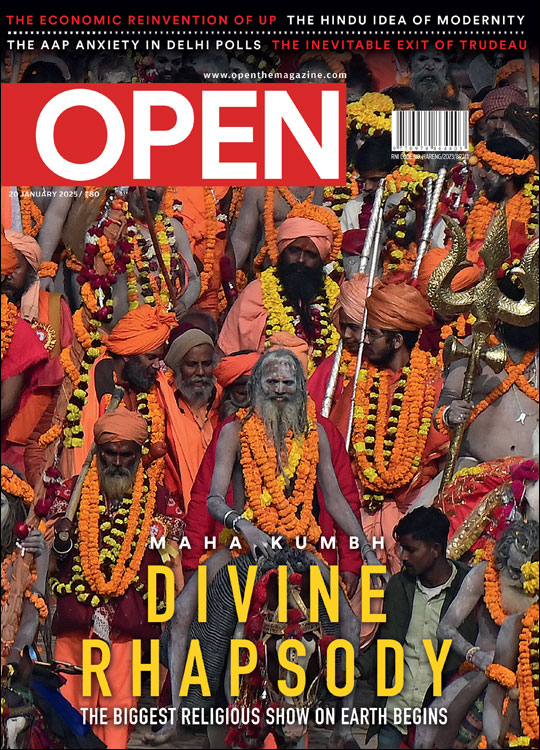Mahendra’s Magic
The Mahabalipuram rock reliefs and sculptures are extraordinary creations by the third monarch of the Pallava dynasty, and in these masterpieces merge the sensuous and the satirical, the human and the divine in timeless harmony
 William Dalrymple
William Dalrymple
 William Dalrymple
William Dalrymple
 |
30 Sep, 2015
|
30 Sep, 2015
/wp-content/uploads/2016/01/19706.mahendramagic1.jpg)
A BRIEF HISTORY OF INDIAN ART THROUGH FIVE MASTERPIECES – PART 2
There is nothing new about India being perceived as a place of great and growing wealth: historically, South Asia was always famous as one of the richest regions of the globe, whose fertile soils gave two harvests a year, and whose mines groaned with minerals. Ever since Alexander the Great first penetrated the Hindu Kush, Europeans fantasised about the wealth of these lands where, according to Greek geographers, gold was dug up by gigantic ants and guarded by griffins, and where precious jewels were said to lie scattered on the ground like dust.
For much of the pre-Colonial period, the West played the role of eager consumer of the spices, silks and luxuries of the Subcontinent, while India was the prosperous supplier. As early as the reign of Nero, there was such a dramatic drain of Western gold to India that Strabo anxiously asks in a letter what can be done to solve the crisis—an image graphically confirmed by the recent find of several huge Roman coin hoards around Tamil Nadu, and the discovery of a large Roman coastal trading post south of Chennai. One south Indian dynasty went as far as to send an embassy to Rome to discuss the Roman balance of payments problem. Even today, the English ‘pepper’ and ‘ginger’ are loan words from Tamil—from ‘pippali’ and ‘singabera’ respectively, testaments to the old spice trade that was once a staple of this lucrative Indian export traffic.
The great Pallava kings of South India were arguably the greatest of these South India dynasties who became rich and powerful from their control of the spice and silk trade. From their great port of Mahabalipuram, near the site of a former Roman trading station, the Pallavas sent naval expeditions to Sri Lanka, Thailand and to South East Asia, where the inscriptions they left still survive as witness to the scale of this first great Indian diaspora. An eighth century Tamil poem speaks of Mahabalipuram as a great port where ‘ships rode at anchor, bent to the point of breaking, laden as they were with wealth, with big-trunked elephants, and with mountains of gems of nine varieties.’
Facing the harbour was the Pallavas’ greatest monumental creation: a massive relief sculpture—the largest in India, know today as Arjuna’s Penance. Today it is marooned a little inland. Originally, it directly faced the waterfront: this was the sight which greeted Indian traders returning from voyages across the Indian Ocean to Java and Bali.
For about 700 years, from about 400 CE, Southern India was a massive and supremely confident exporter of its own civilisation in all its forms, and South East Asia was the willing and eager recipient of a startlingly comprehensive mass-transfer of South Indian soft power—in culture, religion, art, music, technology, astronomy, mythology, language and literature. Tamil literature is full of seafaring expeditions trading gold, precious metals and raw materials. One epic, the Manimekalai, includes stories of merchants who sailed to Java, while the Silappadikaram describes Pallava kings sending off fleets of ships laden with silk, sandalwood, spices and camphor. Out of Mahabalipuram came not just artists, sculptors, traders, scientists, astronomers and the occasional fleets of warships, but also missionaries of three Indic forms of religion— Shaivite and Vaishnava Hinduism, and Buddhism.
Inscriptions in the Tamil script are among the earliest in South East Asia and a testament to the power of the Pallava kings overseas: around 450 CE, a ruler in West Java declared himself in Tamil to be a devotee of Vishnu. There are clear affinities between the sculpture on the Pallava temples in Tamil Nadu and those on the celebrated reliefs at Borobodur in central Java. Four hundred years later, large-scale sculptures in the Pallava style were still being produced at Takuapa on the Malay Peninsula.
But the Pallavas were not just warriors and traders. They were as remarkable at the time for their brilliance as poets and patrons of the arts as they were for their success in trade and on the battlefield.
Mahendra was the third monarch of the Pallava dynasty and ruled from 571 to 630 CE. Taking the titles Vicitracitta (‘The Curious Minded’) and Mattavilasa (‘Drunk with Pleasure’), Mahendra was also an eclectic and innovative poet, a noted musician, a lover of pleasure and a connoisseur of the arts. He was probably the first Hindu ruler to commission a temple made of stone as opposed to wood. He may also have been the ruler who first patronised the casting of bronzes—an art that became in time South India’s most distinctive form of sculpture.
Exquisitely poised and supple, these abstracted and ritualised South Indian bronze deities stand quite silently on their plinths, yet with their hands they speak gently to their devotees through the noiseless lingua franca of the gestures—mudras—of south Indian dance: promising boons and protection, and above all, marriage, fertility and fecundity.
In Western art, few sculptors except perhaps Donatello or Rodin have achieved this pure essence of sensuality so spectacularly evoked by the Pallava and Chola sculptors, or achieved such a sense of celebration of the divine beauty of the human body. There is a startling clarity and purity about the way the near-naked bodies of the Gods come to embody human desire; yet by the simplest devices, the sculptors highlight their joys and pleasures, and above all their appreciation of each other’s beauty. Elsewhere, Hindu sculpture can often be explicitly erotic. But with Pallava sculpture (and later Chola bronzes), the sexual nature of the Gods is strongly implied rather directly stated— in the extraordinary swinging, dancing rhythm of these eternally still figures, in their curving torsos, their slender arms, and their high rounded breasts.
Mahendra may have been a sensualist, but he was also a humourist. He was the author of two now-lost treatises on South Indian painting and music, and the writer of at least two plays. One of these, a cynical and sophisticated satirical farce called The Drunken Courtesan, tells the story of an alcoholic worshipper of Shiva and his equally tipsy courtesan-lover who get into an argument with a decadent Buddhist monk over a drinking bowl left lying in front of a bar in Kanchipuram. The other play is similar in tone: a holy man who is a celebrated saint and ascetic exchanges souls with a beautiful courtesan due to a mix up by Yama, the God of Death. Each character speaks out of the mouth of the other, to the astonishment of the courtesan’s customers and the ascetic’s disciples. The playwright revels in identity mix-ups, puns and double or even triple meanings. Poking fun at both Buddhists and Shaivites, both farces are still regularly performed in the south today, 1,300 years after their composition.
The villages you pass through on the road to Mahabalipuram from the interior are like those in RK Narayan stories: small and unspoiled, with roadside shops full of sacks of dried red chilli and freshly cut stalks of green bananas. This is still a prosperous, gentle and well-to-do part of India. Women in bright silk saris troop along the roads with jasmine flowers in their hair. The villagers leave their newly-harvested grain on the road to be threshed by passing cars. The cattle are strong and white and their long horns are painted red. Amid thick clouds of bronzed dragonflies, you pass into the fertility of the coastal plain, through rice paddy so green it is almost blue.
As you approach the former Pallava port, the road passes strange, unearthly-looking ranges of silver boulders glistening like beads of petrified mercury. The number of ruins littering the landscape suddenly increases: forgotten watch towers and frontier forts lie abandoned amid the fields. Vine-covered walls, tanks and stairways climb up empty hills of jagged scree that were once bustling suburbs of the Pallavas’ port-gateway to the outside world.
Mahendra’s sculptures here are extraordinary creations. They cover one side of an entire hillside and at first sight are remarkable for their striking naturalism: two huge elephants stand, trunks swinging, to the right of the relief. A family of life-size stone monkeys sits beside them; nearby graze deer while a cow is being milked as its licks its calf. Such images jostle with super-human warrior heroes, bearded sages and meditating ascetics. Above floats an airborne cast of gods and goddesses, heavenly nymphs and tree spirits, and snake- hooded nagas and naginis. There is a breezy lightness of touch at work. A flute is playing, there is some dancing, and large-breasted and scantily clad women are cavorting around with their consorts: in some ways, it is pure Bollywood.
Yet it is one of the features of Pallava sculpture that the frontier between the divine and the human remains infinitely porous. In the Vaikuntha Perumal temple, in nearby Kanchipuram that acts as the Pallavas’ dynastic memorial, are freizes which tell of the triumphs of the dynasty. Thirty panels are arranged like a vast dynastic strip- cartoon, where messengers arrive breathless in packed halls of audience and bearded ambassadors from China sue for peace. Wizened ascetics examine omens; beaten monarchs flee to escape the arrows of Pallava archers; chests of booty are carried back from seaborne expeditions; and lines of fettered slaves are led off into captivity.
Amid these scenes of worldly triumph, Vishnu, Brahma and especially Shiva turn up intermittently to give advice at the Pallava court and they regularly intervene in battles. Pictures of the divine family of Lord Shiva directly echo those of the Pallava dynasty: only the number of arms and heads distinguish one from the other. The same playful mind that can be sensed in Mahendra’s plays can be seen here: queens, courtesans and goddesses alike are shown carefree and sensual. Bare-breasted, they tease their menfolk, standing tip-toe to kiss them, hands resting provocatively on their hips. Kings and gods both wear their hair in beehive topknots and sit cross-legged, gazing down from their gaddis under crimson parasols, as the courtiers feast and dancing girls celebrate their victories over the enemy.
The same spirit is even more evident in Mahendra’s masterpiece, his great Mahabalipuram rock reliefs. For here too there is no boundary between the human and divine, and you can catch frequent glimpses in the sculpture of the same eclectic, punning humour that Mahendra exhibits in his plays: one small image at the base of the relief retells the Panchatantra story of the cat who lived beside the Ganges and who used to preach to the local mice about his own enlightenment, his vegetarian abstinence and his great qualities of mercy—only then to feast upon his credulous audience. In the sculpture, the cat is made to stand on his hind legs in the pose of a fasting ascetic, while a gaggle of adoring mice gather at his feet in rapt devotion.
What emerges with a little more study, however, is the sophisticated literary game that Mahendra’s artist is playing. Many of the characters on the Mahabalipuram reliefs look as if they are illustrating the famous scene in the Mahabharata when the hero Arjuna undergoes years of penance and self-punishment in order to learn from Lord Shiva the secrets of the great apocalypse- weapon of the Gods. The same scene, however, is sculpted so that it can also be read in a different direction as the equally famous story of the Descent of the Ganges from heaven to earth into the matted locks of Shiva—the Himalayas.
The final meaning is left open to individual interpretation: the same sort of punning game that Mahendra also has in his plays: the deliberate cultivation of an erudite and witty ambiguity. In an age when religions tend to be both dogmatic and humourless, it is a good moment to remember the satirical tastes of one of India’s greatest patrons of art who was at once a great conqueror and a leading satirist: a combination that hasn’t often been seen in subsequent history anywhere in the world.
Also Read: The Familiar Faces of Ajanta
(Next week: The Deccani art of Bijapur. Read Part I, ‘The Familiar Faces of Ajanta’.)

/wp-content/uploads/2025/01/Cover_Kumbh.jpg)











More Columns
The lament of a blue-suited social media platform Chindu Sreedharan
Pixxel launches India’s first private commercial satellite constellation V Shoba
What does the launch of a new political party with radical background mean for Punjab? Rahul Pandita